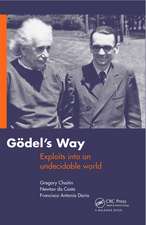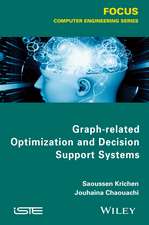Queueing Theory: A Linear Algebraic Approach
Autor Lester Lipskyen Limba Engleză Paperback – 29 oct 2010
This book can be considered to be a monograph or a textbook, and thus is aimed at two audiences: those who already know Queueing Theory but would like to know more of the Linear Algebraic Approach; and as a rst course for students who don't already have a strong background in probability, and feel more comfortable with algebraic arguments. Also, the equations are well suited to easy computation. In fact, there is much discussion on how various properties can be easily computed in any language that has automatic matrix operations (e.g., MATLAB). To help with physical insight, there are over 80 gures, numerous examples and exercises distributed throughout the book. There are, perhaps 50 books on QT that are available today, and most practitioners have several of them on their shelves. This book would be a good addition, as well as a good supplement to another text.
This second edition has been updated throughout including a new chapter on Semi Markov Processes and new material on matrix representations of distributions and Power-tailed distribution.
Lester Lipsky is a Professor in the Department of Computer Science and Engineering at the University of Connecticut.
| Toate formatele și edițiile | Preț | Express |
|---|---|---|
| Paperback (1) | 403.91 lei 6-8 săpt. | |
| Springer – 29 oct 2010 | 403.91 lei 6-8 săpt. | |
| Hardback (1) | 408.92 lei 6-8 săpt. | |
| Springer – 6 noi 2008 | 408.92 lei 6-8 săpt. |
Preț: 403.91 lei
Nou
Puncte Express: 606
Preț estimativ în valută:
77.31€ • 84.01$ • 64.98£
77.31€ • 84.01$ • 64.98£
Carte tipărită la comandă
Livrare economică 22 aprilie-06 mai
Preluare comenzi: 021 569.72.76
Specificații
ISBN-13: 9781441923868
ISBN-10: 1441923861
Pagini: 572
Ilustrații: XIV, 548 p.
Dimensiuni: 155 x 235 x 30 mm
Greutate: 0.79 kg
Ediția:Softcover reprint of hardcover 2nd ed. 2009
Editura: Springer
Colecția Springer
Locul publicării:New York, NY, United States
ISBN-10: 1441923861
Pagini: 572
Ilustrații: XIV, 548 p.
Dimensiuni: 155 x 235 x 30 mm
Greutate: 0.79 kg
Ediția:Softcover reprint of hardcover 2nd ed. 2009
Editura: Springer
Colecția Springer
Locul publicării:New York, NY, United States
Public țintă
Professional/practitionerCuprins
M/M/1 Queue.- M E Functions.- M/G/1 Queue.- G/M/1 Queue.- M/G/-Type Systems.- G/G/1/N/Loop.- Semi Markov Process.- L A Q T.
Recenzii
From the reviews of the second edition:
“In this book, which is in the second edition now … the author presents queueing concepts from the linear algebraic point of view. … The book will be a good addition to the library of researchers in queueing theory. It is more suitable for senior graduate level and doctoral students.” (Srinivas Chakravarthy, Mathematical Reviews, Issue 2010 f)
“This is the 2nd edition of the text book which is intended ‘for those who know queueing theory, but would like to know more about the linear algebraic approach’. On the other hand it can be used as ‘a textbook in a first course in queueing theory’ for the students who know more matrices and algebraic approach than the probability theory. Much discussion on computational aspects including matrix operations (supported by languges MATLAB, Mathematica, Maple) is presented.” (Evsen Morozov, Zentralblatt MATH, Vol. 1169, 2009)
“In this book, which is in the second edition now … the author presents queueing concepts from the linear algebraic point of view. … The book will be a good addition to the library of researchers in queueing theory. It is more suitable for senior graduate level and doctoral students.” (Srinivas Chakravarthy, Mathematical Reviews, Issue 2010 f)
“This is the 2nd edition of the text book which is intended ‘for those who know queueing theory, but would like to know more about the linear algebraic approach’. On the other hand it can be used as ‘a textbook in a first course in queueing theory’ for the students who know more matrices and algebraic approach than the probability theory. Much discussion on computational aspects including matrix operations (supported by languges MATLAB, Mathematica, Maple) is presented.” (Evsen Morozov, Zentralblatt MATH, Vol. 1169, 2009)
Textul de pe ultima copertă
Queueing Theory deals with systems where there is contention for
resources, but the demands are only known probabilistically. This book can
be considered as either a monograph or a textbook on the subject, and thus
is aimed at two audiences. It can be useful for those who already know
queueing theory, but would like to know more about the linear algebraic approach.
It can also be used as a textbook in a first course on queueing theory for
students who feel more comfortable with matrices and algebraic arguments than
with probability theory. The equations are well-suited to easy computation.
The text has much discussion on how various properties can be computed using any
language that has built-in matrix operations (e.g., MATLAB, Mathematica, Maple).
To help with physical insight, there are over 80 figures, numerous examples,
and many exercises distributed throughout the book.
There are over 50 books on queueing theory that are available today and
most practitioners have several of them on their shelves. Because of its
unusual approach, this book would be an excellent addition. It would also
make a good supplement where another book was selected as the primary text
for a course in system performance modelling.
This second edition has been greatly expanded and updated thoughout, including
a new chapter on semi-Markov processes and new material on representations
of distributions. In particular, there is much discussion of power-tailed
distributions and their effects on queues.
Lester Lipsky is a professor in the Department of Computer Science and
Engineering at the University of Connecticut.
resources, but the demands are only known probabilistically. This book can
be considered as either a monograph or a textbook on the subject, and thus
is aimed at two audiences. It can be useful for those who already know
queueing theory, but would like to know more about the linear algebraic approach.
It can also be used as a textbook in a first course on queueing theory for
students who feel more comfortable with matrices and algebraic arguments than
with probability theory. The equations are well-suited to easy computation.
The text has much discussion on how various properties can be computed using any
language that has built-in matrix operations (e.g., MATLAB, Mathematica, Maple).
To help with physical insight, there are over 80 figures, numerous examples,
and many exercises distributed throughout the book.
There are over 50 books on queueing theory that are available today and
most practitioners have several of them on their shelves. Because of its
unusual approach, this book would be an excellent addition. It would also
make a good supplement where another book was selected as the primary text
for a course in system performance modelling.
This second edition has been greatly expanded and updated thoughout, including
a new chapter on semi-Markov processes and new material on representations
of distributions. In particular, there is much discussion of power-tailed
distributions and their effects on queues.
Lester Lipsky is a professor in the Department of Computer Science and
Engineering at the University of Connecticut.
Caracteristici
Chapter Summaries Detailed Illustrations Numerous Examples The Exercises are often extensions of the examples. Includes supplementary material: sn.pub/extras














